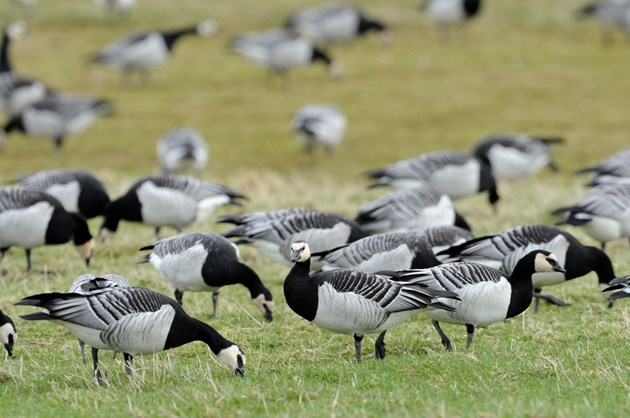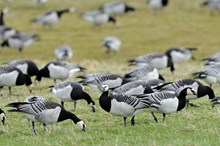11 April, 2023
Significant Scottish report on avian flu released today

A major report into avian flu in wild birds in Scotland, published today by NatureScot, concludes that long-term conservation measures will be the most effective tool against this devastating virus.
The study, by a sub-group of NatureScot’s Scientific Advisory Committee, analyses the unprecedented avian flu outbreak among wild birds since 2021, providing advice to support the work of Scotland's Avian Flu Task Force.
The report assesses that avian flu will likely continue to be an issue among wild birds into the 2023 nesting season and beyond. It finds that the most effective solutions will likely be long-term conservation measures for birds which are particularly susceptible, accompanied by enhanced disease surveillance, demographic monitoring, and continued research.
The report also looks at the effectiveness and benefits of short-term measures and provides a picture of how avian flu has affected Scotland's wild birds so far. It finds that once avian flu is present in a wild bird population, it is very difficult to control or reduce it. Measures such as carcass removal or reducing human activity across sites, for example, whether for recreation or monitoring are unlikely to significantly reduce the impact of an outbreak on wild birds.
The number of wild birds affected by avian flu in Scotland is difficult to estimate as many dead birds are not found or reported. But, an example of one of the worst hit species is Svalbard barnacle goose population, where the virus was first detected in late October 2021 in the Solway Firth. By the end of the winter, estimates suggest that 13,200 birds - around one third of the migrating population – had been killed by the virus.
This year, it has been the Greenland barnacle geese population that winter on Islay that have been most affected by the virus, with 1,190 deaths recorded and local population counts suggesting actual losses of at least 5,000 birds. Other species that have suffered notable mortalities over the winter are pink-footed geese, herring gulls and mute swans.
Alastair MacGugan, a NatureScot Wildlife Manager, said: “Although there’s no silver bullet to solve this complicated dilemma, this report will be a great help as the Avian Influenza Task Force plan action to reduce the effect of avian flu on Scotland’s important populations of wild birds. This is an upmost priority for our partners and ourselves, as the geographic scale, range of species of wild birds affected, and severity of impacts may threaten the very survival of some species.
“We have already stepped up our collaborative monitoring work in Scotland, and will continue to build on the recommendations in this vital report to make sure seabirds in Scotland have the best chance possible to rebound from the effects of this disease.”
Professor Dan Haydon, Chair of the sub-group, and population ecologist at the University of Glasgow, added: “This is an important and timely piece of work to help protect Scotland’s vital seabird populations. We were pleased to be able to collaborate with a range of experts and advise on the route we need to take to better understand this avian flu outbreak and help manage seabirds into the future.”
Scotland’s Avian Influenza Task Force, led by NatureScot, has been working at speed to further understand how the virus is transmitted and what practical actions can be put in place to help seabirds and other species in the event that they are hit by the outbreak again. For more on the action being taken already, see this recent NatureScot news release.
ENDS
Contact information
- Name
- NatureScot Media
- Telephone
- 0131 316 2655
- media@nature.scot
Notes to editors
For the full report, see: https://www.nature.scot/doc/naturescot-scientific-advisory-committee-sub-group-avian-influenza-report-h5n1-outbreak-wild-birds
Scotland’s Avian Flu Taskforce was established in July 2022 to co-ordinate a national response to the avian influenza crisis devastating vulnerable seabirds, and other wild bird populations in Scotland. For more information on the taskforce, its membership and remit, see: https://www.nature.scot/doc/avian-influenza-bird-flu
The Great Britain Dead Wild Bird Surveillance Scheme is administered by Defra on behalf of all GB administrations. For more information, see: https://www.gov.scot/publications/avian-influenza-bird-flu/pages/dead-or-sick-wild-birds-what-to-do/
The Seabird Monitoring Programme (SMP) monitors the population changes of our internationally important breeding seabird species at coastal and inland colonies across the UK. The SMP is funded jointly by the British Trust for Ornithology and Joint Nature Conservation Committee, in association with the Royal Society for the Protection of Birds, and is supported by Natural England, Natural Resources Wales, NatureScot and the Department of Agriculture, Environment and Rural Affairs, Northern Ireland, and a wider advisory group. For more information see: https://www.bto.org/our-science/projects/seabird-monitoring-programme
NatureScot is Scotland's nature agency. We work to enhance our natural environment in Scotland and inspire everyone to care more about it. Our priority is a nature-rich future for Scotland and an effective response to the climate emergency. For more information, visit our website at www.nature.scot or follow us on X at https://x.com/NatureScot
’S e NatureScot buidheann nàdair na h-Alba. Bidh sinn a’ neartachadh àrainneachd na h-Alba agus a’ brosnachadh dhaoine gu barrachd suim a chur ann an nàdar. Tha e mar phrìomhachas againn gum bi nàdar na h-Alba beairteach agus gun dèilig sinn gu h-èifeachdach le èiginn na gnàth-shìde. Tha an tuilleadh fiosrachaidh aig www.nature.scot no air X aig https://x.com/NatureScot

